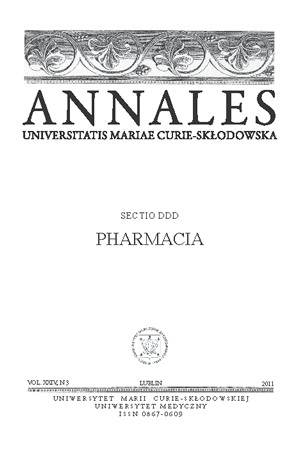Influence of osthole on the anticonvulsant activity of phenytoin and valproate in the maximal electroshock-induced seizures in mice
DOI:
https://doi.org/10.12923/Keywords:
Osthole, phenytoin, valproate, maximal electroshock seizure testAbstract
Accumulating evidence indicates that some naturally occurring substances extracted from plants and herbs possess anticonvulsant properties. One of these substances is osthole isolated from Peucedanum ostruthium (L.) Koch. Therefore, the aim of this study was to determine the effect of osthole on the anticonvulsant activity of two classical antiepileptic drugs (AEDs: phenytoin [PHT] and valproate [VPA]) in the mouse maximal electroshock seizure (MES) model. Electroconvulsions (tonic-clonic seizures) were evoked in adult Albino Swiss mice by a current (25mA, 50Hz, 500V, 0.2s stimulus duration,) delivered via auricular electrodes. Adverse-effect profiles of the combination of osthole with PHT and VPA with respect to motor performance, long-term memory and skeletal muscular strength were measured. Total brain concentrations of PHT and VPA were estimated to characterize the interaction profile between osthole and classical AEDs. Results indicate that osthole administered intraperitoneally (i.p.) at doses of 50, 100 and 150 mg/kg did not significantly affect the protective action of PHT and VPA in the MES test in mice. Moreover, osthole in combination with PHT and VPA did not alter motor performance, long-term memory or skeletal muscular strength in experimental animals. Additionally, osthole had no significant impact on total brain concentrations of PHT and VPA in mice. The present study demonstrates that osthole had no significant effect on the anticonvulsant action of PHT and VPA in the mouse MES model. If the results from this study could be extrapolated into clinical settings, osthole combined with PHT and VPA would offer neutral pharmacodynamic interaction.
References
1. Boissier J.R., Tardy J., Diverres J.C.: Une nouvelle méthode simple pour explorer l’action tranquilisante: le test de la cheminée. (in French) Med. Exp. (Basel) 3, 81, 1960.
2. Borowicz K.K., Świąder M., Łuszczki J.J., et al.: Effect of gabapentin on the anticonvulsant activity of antiepileptic drugs against electroconvulsions in mice: an isobolographic analysis. Epilepsia 43, 956, 2002.
3. Czuczwar S.J., Chodkowska A., Kleinrok Z., et al.: Effects of calcium channel inhibitors upon the efficacy of common antiepileptic drugs. Eur. J. Pharmacol. 176, 75, 1990.
4. Dooley D.J., Taylor C.P., Donevan S., et al.: Ca2+ channel alpha2delta ligands: novel modulators of neurotransmission. Trends Pharmacol. Sci., 28, 75, 2007.
5. Genovese S., Epifano F., Curini M., et al.: Prenyloxyphenylpropanoids as a novel class of anticonvulsive agents. Bioorg. Med. Chem. Lett. 19, 5419, 2009.
6. Johannessen Landmark C., Patsalos P.N.: Interactions between antiepileptic drugs and herbal medicines. Bollatinoam. Caribe. Plantmedy. Aromat. 7, 108, 2008.
7. Kaminski R., Jasinski M., Jagiello-Wojtowicz E., et al.: Effect of amlodipine upon the protective activity of antiepileptic drugs against maximal electroshock-induced seizures in mice. Pharmacol. Res. 40, 319, 1999.
8. Kwan P., Brodie M.J.: Early identification of refractory epilepsy. N. Engl. Med. 342, 314, 2000.
9. Kwan P., Brodie M.J.: Epilepsy after the first drug fails: substitution or add-on? Seizure 9, 464, 2000.
10. Litchfield J.T., Wilcoxon F.: A simplified method of evaluating dose-effect experiments. J. Pharmacol. Exp. Ther. 96, 99, 1949.
11. Löscher W., Fassbender C.P., Nolting B.: The role of technical, biological and pharmacological factors in the laboratory evaluation of anticonvulsant drugs. II. Maximal electroshock seizure models. Epilepsy Res. 8, 79, 1991.
12. Łuszczki J.J.: Additive interaction of pregabalin with phenytoin in the mouse maximal electroshock-induced seizure model: an isobolographic analysis. Ann. UMCS Sect. DDD, 22, 31, 2009.
13. Łuszczki J.J., Andres-Mach M., Cisowski W., et al.: Osthole suppresses seizures in the mouse maximal electroshock seizure model. Eur. J. Pharmacol. 607, 107, 2009.
14. Łuszczki J.J., Antkiewicz-Michaluk L., Czuczwar S.J.: Isobolographic analysis of interactions between 1-methyl-1,2,3,4-tetrahydroisoquinoline and four conventional antiepileptic drugs in the mouse maximal electroshock-induced seizure model. Eur. J. Pharmacol. 602, 298, 2009.
15. Łuszczki J.J., Głowniak K., Czuczwar S.J.: Imperatorin enhances the protective activity of conventional antiepileptic drugs against maximal electroshock-induced seizures in mice. Eur. J. Pharmacol. 574, 133, 2007.
16. Łuszczki J.J., Głowniak K., Czuczwar S.J.: Time-course and dose-response relationships of imperatorin in the mouse maximal electroshock seizure threshold model. Neurosci. Res. 59, 18, 2007.
17. Łuszczki J.J., Świąder M., Czuczwar M., et al.: Interactions of tiagabine with some antiepileptics in the maximal electroshock in mice. Pharmacol. Biochem. Behav. 75, 319, 2003.
18. Łuszczki J.J., Wojda E., Andres-Mach M., et al.: Anticonvulsant and acute neurotoxic effects of imperatorin, osthole and valproate in the maximal electroshock seizure and chimney tests in mice: a comparative study. Epilepsy Res. 85, 293, 2009.
19. Łuszczki J.J., Wojda E., Raszewski G., et al.: Influence of imperatorin on the anticonvulsant activity and acute adverse-effect profile of lamotrigine in maximal electroshock-induced seizures and chimney test in mice. Pharmacol. Rep. 60, 566, 2008.
20. Meyer O.A., Tilson H.A., Byrd W.C., et al.: A method for the routine assessment of fore- and hindlimb grip strength of rats and mice. Neurobehav. Toxicol. 1, 233, 1979.
21. Venault P., Chapouthier G., de Carvalho L.P., et al.: Benzodiazepine impairs and beta-carboline enhances performance in learning and memory tasks. Nature 321, 864, 1986.
22. Wang S.J., Lin T.Y., Lu C.W., et al.: Osthole and imperatorin, the active constituents of Cnidium monnieri (L.) Cusson, facilitate glutamate release from rat hippocampal nerve terminals. Neurochem. Int. 53, 416, 2008.
23. Wu S.N., Lo Y.K., Chen C.C., et al.: Inhibitory effect of the plant-extract osthole on L-type calcium current in NG108-15 neuronal cells. Biochem. Pharmacol. 63, 199, 2002.
24. Zaugg J., Eickmeier E., Rueda D.C., et al.: HPLC-based activity profiling of Angelica pubescens roots for new positive GABAA receptor modulators in Xenopus oocytes. Fitoterapia 82, 434, 2011.
Downloads
Published
Issue
Section
License
Copyright (c) 2011 Authors

This work is licensed under a Creative Commons Attribution-NonCommercial-NoDerivatives 3.0 Unported License.


